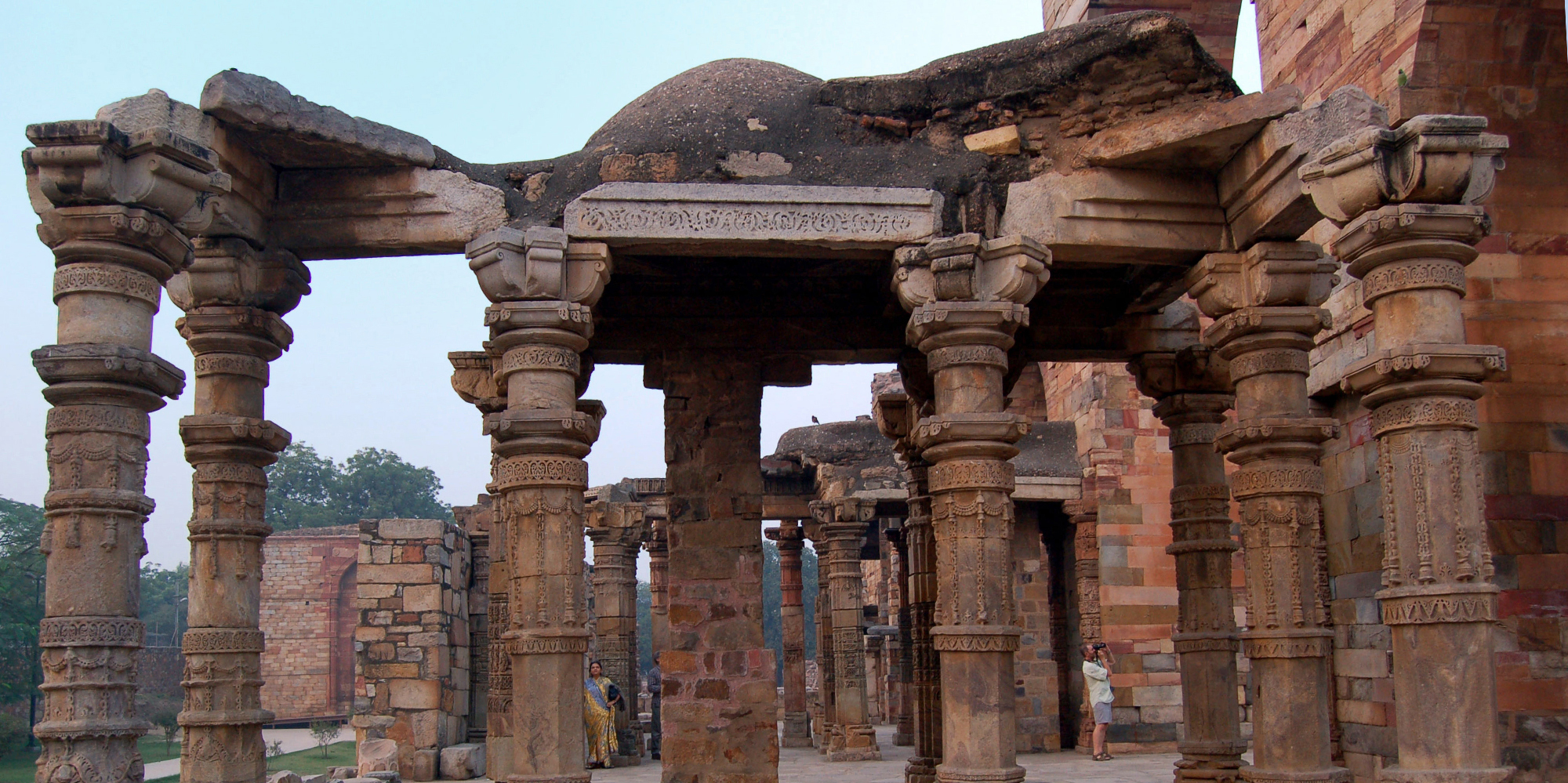Qutab Minar Travel Information
Qutab Minar Description:
The Qutab Minar complex is one of the most iconic attractions in the Indian Federal Capital of New Delhi. The Qutab Minar is said to be one of the world’s tallest free standing brick tower. The tower was envisioned as a minaret for the call to prayer as well as a tower of victory by Sultan Qutubuddin Aibak, one of the earliest Muslim rulers of Delhi.
The Qutab Minar was built by the Sultanate of Delhi, the first Muslim kingdom in Delhi. The tower was built as part of a great complex of monuments commemorating the victory of Turkic Muslims over the last Hindu Kingdom of Delhi. It is chronicled that a large number of Turkish artisans were employed and brought to India to design and build the Qutab Minar.
The Qutab Minar at the time of its construction, which began in 1193, was a monumental undertaking and engineering feat. The tower is 239 feet (73 meters) tall. The tower has a tapering design with a diameter at its base of 15 meters which becomes 2.5 meters at the apex. The tower initially had three storeys however successors to Sultan Aibak during the Mamlukian Slave Dynasty that ruled Delhi added another two floors. The first three storeys of the tower are made out of marble while the last two are made from Sandstone.
Externally the Qutab Minar has a very interesting design, the tower is covered by beautifully intricate calligraphy of Koranic text in the Nakhsh script. The Qutab Minar has other interesting features such as superimposed, flanged and cylindrical shafts to support the structure, protruding balconies on each storey as well as Murqana Corbels that have fascinated fans of architecture and structural engineering over the years. Another interesting fact about the Qutab Minar is that the tower tilts 60 centimeters from the vertical. While many attribute this to a weakening of the base over time, the structure is regularly monitored by Indian authorities and is deemed safe by experts.
The Qutab Minar was said to have been inspired by the Minaret of Jam in Afghanistan and the tower along with other relics in the Qutab Minar Complex are said to be the earliest examples of Islamic architecture in India which kicked off a period of over seven centuries of Muslim ascendance in the Indian Subcontinent.
There is much debate on who the tower was named after. Many historians claim that the tower was named eponymously after its creator Sultan Qutubuddin Aibak, many others contend that it was named after Shaikh Qutubuddin Kaki, a Sufi saint of Transoxiana who was instrumental in the spread of Islam in North India and was widely venerated by the Sultans of Delhi.
Over the course of the years, the Qutab Minar has been subject to major restoration exercises primarily as a result of the tower being hit by a natural calamity such as lightning strikes and earthquakes. During the many years, two cupolas were erected on top of the tower, the first by Sultan Feroz Shah Tughlaq of Delhi and the second by British Imperial engineers, both however were later removed and are now placed in the periphery of the tower as attractions in the Qutab Minar Complex.
At the foot of the Qutab Minar monument, there are the remains of the first ever Islamic mosque built in the Indian Subcontinent. The mosque was titled the Masjid Quwwat-ul-Islam (Might of Islam) and was said to have been built from materials of 27 local Hindu and Jain shrines that were destroyed in the conquest of the Delhi region by the Turkic Muslims.
The mosque was built in the year 1198 on the grounds of what is said to be an ancient Hindu temple, there are still some Hindu and Jain decorations in the walls of the remnants of the Quwwat-ul-Islam Mosque giving further credence to the story of how its building materials were sourced through other temples. In front of the mosque is the main gate to enter the Qutab Minar Complex which is called the Alai Darwaza (Gate).
The Alai Darwaza was named after Sultan Alauddin Khilji who greatly expanded the complex. He wanted to outdo the Qutab Minar by building the Alai Minar as another victory monument which would be a tower that was twice as high as the Qutab Minar. He however died and the ambitious project was abandoned resulting in a huge pile of rubble just north of the present day Qutab Minar.

Within the courtyard of the Quwwat-ul-Islam Mosque is a 7 meter high pillar called the Asoka Pillar. The Pillar is said to have been brought from a Vishnu Shrine in Bihar which honored the legendary Hindu King Chandragupta Maurya. The Pillar is a source of considerable interest to experts as it has not rusted in over 2000 years despite being exposed to the elements and Delhi’s weather. Scientists to date are befuddled as to how the Iron pillar was cast as the technology to do so did not exist at the time.
Also in the periphery of the Qutab Minar is the shrine of a local Sufi saint Imam Zamin. The shrine sees a steady stream of local devotees and also is the site of the graves of many famous Delhi Sultans including Iltutmish, Alauddin Khilji, many of the minor Mughal Emperors. Interestingly, the shrine also has an empty symbolic grave of Bahadur Shah Zafar-II, the last Mughal Empire, who was a Sufi devotee and wished to be buried here. The British Rulers of India however exiled him to Rangoon after he was convicted of inciting rebellion against the Crown in 1857 AD thereby replacing Muslim ascendance with British supremacy in India. Fans of history appreciate the irony that the Qutab Minar Complex therefore marks both the beginning and the end of Muslim ascendancy in the Indian Subcontinent.
Best Time to Visit Qutab Minar:
The period between October to March is undoubtedly the best time to visit the Qutab Minar Complex in Delhi. The weather in the city is pleasant and the monsoons and the sizzling Delhi summers do not cause any disruptions of a tour to the Qutab Minar and its nearby attractions.
While Delhi is a great place to enjoy the many famous festivals of India such as Dussehra and Diwali, there is a famous annual festival that is held on the grounds of the Qutab Minar every October and November. The festival is called the Qutab Festival and features some amazing performances of traditional performing arts of the region. These include classical dance, poetry, music, Ghazals and Qawwali renditions.
Furthermore there is a decorative light show every night at the Qutab Minar Complex which is popular with local Delhiites and foreign visitors alike.
How to get to Qutab Minar:
The Qutab Minar is located in Delhi, India’s bustling Federal Capital. Delhi is situated in the north of India and is a federally administered territory located ideally between the states of Uttar Pradesh, Punjab and Rajasthan. All three states are amongst the most popular destinations with international tourists visiting India.
The best way to come and take a tour of the Qutab Minar for the foreign visitor is to fly into Delhi’s Indira Gandhi International Airport, the largest aviation hub in India. The airport has modern facilities and connects Delhi to over 100 international destinations conveniently through a variety of international carriers.
Qutab Minar Highlights:
The Qutab Minar and the monuments are sure to interest fans of history, culture, engineering, and architecture. The Minar itself along with the nearby Ashoka Pillar provide visitors with an amazing example of how ancient civilizations accomplished great feats of engineering that still continue to boggle the mind.
Visitors to the Qutab Minar complex will also see first-hand the example of how the many changing social and governance orders in India have had an impact on the development of the country.
Appropriate Attire :
Since Delhi has a tropical climate for most of the year apart from the October to January winter months, loose cotton clothing that covers arms, legs and shoulders will serve visitors best when touring attractions such as the Qutab Minar Complex.
It is also worth remembering that most visitors to Delhi visit the Qutab Minar Complex as a part of a greater sightseeing tour of the city which includes visits to national monuments, multiple places of worship as well as historical monuments. It is therefore advisable that visitors wear clothing that is breathable and keep themselves well hydrated. Also some temples and mosques on the itinerary may require female guests to cover their hair so keeping a wrap is also advisable.

